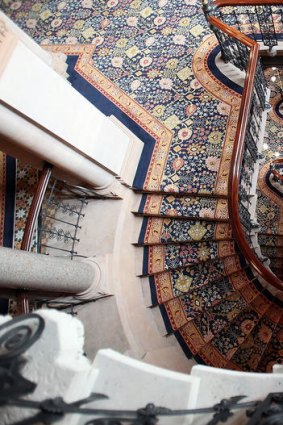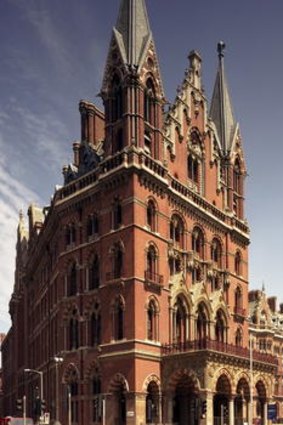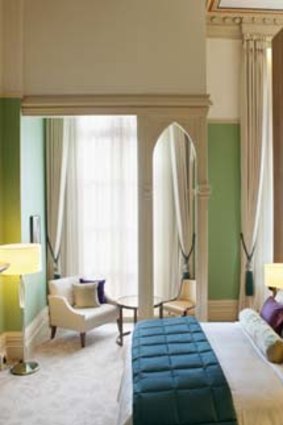
Renaissance in the city ... the wrought-iron Grand Staircase.Credit: Getty Images
High Gothic drama greets Saska Graville up the stairs and down the corridors of an establishment returned to its former Victorian glory.
NOT many hotel tours include stories of ghostly visions of Victorian gentlemen but then not many hotels have their own historian to show guests around.
The St Pancras Renaissance Hotel London is a pretty special place - and not just because of its supernatural residents. After five minutes in the company of in-house historian Royden Stock, you quickly see why he has spent the past 15 years of his working life obsessed with this architectural masterpiece.
The original hotel, the Midland Grand Hotel, was the creation of eminent Victorian architect Sir George Gilbert Scott and opened by Queen Victoria in 1873. A showcase for the Gothic Revival style, it confidently heralded the arrival of the Midland Railway company in London and quickly became one of the city's starriest and most expensive hotels.
Everything about it was larger than life. Building materials chosen to show off the best of the Midlands included 14 different types of granite and limestone, and surfaces were decorated with gold leaf, stencilling and murals. It was the first privately owned building to boast water-driven lifts, or hydraulic ascending chambers as they were known. No wonder the final bill was £438,000 - about £438 million ($654 million) in today's money.
And then it all went wrong. The costs of running the place, combined with tricky issues such as not enough en suite bathrooms (and floors too thick to introduce new plumbing) meant the hotel closed in 1935 to become offices for British Rail staff. Quite a fall from grace. Office life meant false ceilings, cheap paintwork and a total neglect of Gilbert Scott's glorious work.

The Gothic Revival grandeur of St Pancras.
There was even the threat of demolition. It could have been a sorry end to the St Pancras story, were it not for a campaign led by the poet Sir John Betjeman in the 1960s, which resulted in the fading building being safeguarded with a Grade 1 listed status. It remained closed as a hotel, however, instead earning its living as a location for films including Batman Begins and Bridget Jones's Diary, and music videos such as the Spice Girls' debut Wannabe (starring the hotel's Grand Staircase).
This is where Royden Stock comes in. As head of security during those years, he fell in love with the place. When it was reopened this year after a £150 million renovation, who better to serve as the on-site historical expert. As he walks you up that majestic Grand Staircase, with its wrought-iron balustrading that twists upwards to the painted vaulted ceiling, it's easy to share his passion for Gilbert Scott's creation. The effect is heart-stopping. With red walls stencilled by hand with gold fleur de lys, richly patterned carpet and carved stonework, there is decoration and drama everywhere you look.
The Grand Staircase isn't St Pancras's only heart-stopper. Walk down one of the several spacious corridors (wide enough for two Victorian ladies to sweep past each other in their bustles) and you come to the Ladies Smoking Room. The first place in Europe where ladies were allowed to smoke in public, it's a beautiful space of granite columns, an elaborately painted 5.5-metre-high ceiling (restored at a cost of £250,000) and giant marble fireplaces. On the floor below is the Gilbert Scott Bar, a jewel-like room of elaborately carved, gold-painted stonework beneath a richly painted ceiling.

St Pancras's rooms lack the impact of the rest of the hotel.
There are architectural and decorative wonders everywhere you look - no surprise that Stock walks the corridors all day with an endless stream of enchanted guests.
Standing in a spot that overlooks the main reception area, observing curious members of the public walking in to stare at the renovations, it's clear the hotel has something unique. Not just history but drama and intrigue. It is, after all, built alongside Britain's only international train station, with the Eurostars lined up on the platform next door to check-in. Adventure, literally, on the doorstep.
There's also something special about walking down to breakfast, gazing out of the huge windows overlooking the trains and daydreaming of Paris for lunch. (The view is made even more dramatic by the giant Olympic rings hanging in the station for London 2012.) A hotel stay doesn't usually inspire such romantic notions.
Which is where my only gripe comes in. This is one of London's most spectacularly romantic buildings and yet my room is surprisingly staid. Architecturally, it is breathtaking - soaring ceilings, huge vaulted windows, oversized stone fireplace - but whoever was in charge of the interior design didn't share Gilbert Scott's love of pattern and colour.
The overall effect is beige. I wanted gold stencilling and rich shades of blues, reds and oranges. Quite frankly, I want to go to sleep surrounded by High Gothic drama. What I get is undoubted luxury but also a slight sense of disappointment. The rest of the building promised so much more.
Slightly corporate bedroom decor aside, the reopening of St Pancras as a hotel is a wonderfully happy ending to Gilbert Scott's story. His monument to Victorian Gothic Revival is very much a part of 21st-century London - and some of his original visitors have, it seems, come along for the ride.
Yes, those ghost stories. Stock himself has seen a "Victorian gentlemen" leaning against the wall in one of the original men's urinals. Not just a one-off sighting, either; he has seen him out of the corner of his eye every time he's gone into the room. As did more than 100 other people. Other sightings include an old lady wandering the corridors on the first floor. It all adds to the drama and impact of the place. The building Sir John Betjeman described as "too beautiful and too romantic to survive" has proved its staying power.
The writer was a guest of the St Pancras Renaissance Hotel.
Trip notes
Where St Pancras Renaissance Hotel London, Euston Road, London, +44 207 8413540, marriott.co.uk/st.pancras.
How much Room rates from £300 ($449) in Barlow House, a new extension to the hotel and from £650 in the older Chambers Club rooms.
Top marks Breathtaking architecture, a world-class sense of history and all the luxuries of a top hotel.
Black mark The slightly uninspiring bedroom decor. Somehow the romance of the rest of the building stops when you reach your room.
Don't miss Dinner at The Gilbert Scott restaurant, run by one of Britain's top chefs, Marcus Wareing. The menu of British produce is delicious. My Cornish sea bass pan-fried with smoked haddock was mouth-watering.
Sign up for the Traveller Deals newsletter
Get exclusive travel deals delivered straight to your inbox. Sign up now.